|
Automatic aspiration Instrument
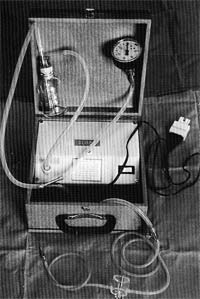 The prototype was assembled by S Catania in 1983 (Figures 3.59, 3.60) with the aim of eliminating most of the disadvantages of the traditional aspiration technique and, at the same time, of maintaining the advantages of the needle-only approach. The prototype was assembled by S Catania in 1983 (Figures 3.59, 3.60) with the aim of eliminating most of the disadvantages of the traditional aspiration technique and, at the same time, of maintaining the advantages of the needle-only approach.
The instrument was tested at the breast out-patient clinic of the Buzzi Hospital in Milan where it has been in use since 1985. The instrument was further improved with the co-operation of R Zambelli (Sterylab Co, Milan, Italy). Presently it consists of an automatic pump, exerting negative or positive pressure by remote pedal control (Figures 3.61-3.64), allowing the following improvements in performance:
- The technique of the single needle may be used with all its advantages of precision and
manoeuvrability. The needle is connected to the pump by a flexible plastic tube which does not
disturb movements. Special needles maybe used that have a magnifying lens inserted in the plastic
cone to allow immediate identification of aspirated material (Figure 1)
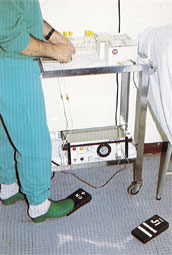
- Sampling from tissue other than the lesion may be reduced. In fact, during the progression
of the needle from the skin surface to the lesion a small positive pressure (pneumatic mandrel)
in the system prevents other material (such as subcutaneous fat) from entering the lumen.
- The intensity of aspiration may be varied according to the consistency of the lesion.
- Reversing the pump action to positive pressure allows the expulsion of all the aspirated
material almost without any loss.
- The sampling is performed according to the same phases as conventional aspiration employing
the syringe and the handle.
Phase I: penetration of the skin and progression to the lesion
The pressure in the system is 10 cm H2O to prevent material from entering the needle.
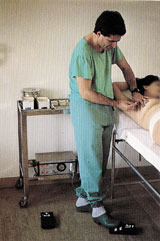
Phase II: needling of the lesion
The desired negative pressure is applied to the system. The negative pressure measured for different syringe types on full aspiration is:
10 ml syringe = -60 cm Hg
20 ml syringe = -67 cm Hg
30 ml syringe = -70 cm Hg
50 ml syringe = -72 ton Hg,
whereas the system allows for a maximum of -74 cm Hg roughly corresponding to that obtained with a 100ml syringe. This pressure is not reported to damage the aspirated cells. The pressure regulation is controlled by a knob in the course of the sampling and the corresponding pressure value is displayed on a manometer. In case of cyst aspiration the aspiration pressure remains constant
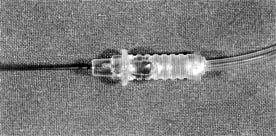 Phase III: end of needling and extraction of the needle Phase III: end of needling and extraction of the needle
As soon as the aspirating action of the pump is interrupted the residual negative pressure in the system drops to O. This avoids the disadvantage of the classic aspiration technique where the return of the piston may cause expulsion of the aspirated material and cancer cell seeding.
Phase IV: spreading the material on the glass
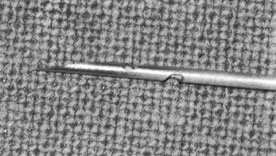 With the conventional technique the expulsion of all the aspirated material is difficult and a certain amount of material is usually lost unless some manoeuvre is adopted to recover it. Some material remains in the needle cone where it is visible and a few drops may be recovered by beating the needle cone on to the slide.
The automatic pump may exert a 1.5 atm positive pressure which is enough to expel all the material in the system. The positive pressure may be adjusted by a knob. Apart from expelling the aspirated material the air jet may be used to ensure a better spread on the glass.
The pump is equipped with two pedals, one for remote control of aspiration, placed near the patient, and the other controlling the positive pressure, placed near the table for smear preparation. With the conventional technique the expulsion of all the aspirated material is difficult and a certain amount of material is usually lost unless some manoeuvre is adopted to recover it. Some material remains in the needle cone where it is visible and a few drops may be recovered by beating the needle cone on to the slide.
The automatic pump may exert a 1.5 atm positive pressure which is enough to expel all the material in the system. The positive pressure may be adjusted by a knob. Apart from expelling the aspirated material the air jet may be used to ensure a better spread on the glass.
The pump is equipped with two pedals, one for remote control of aspiration, placed near the patient, and the other controlling the positive pressure, placed near the table for smear preparation.
|

